Return to the list of my pages written in English about the two envelopes problem
"E=p (x/2) + (1-p) 2x" .
Original
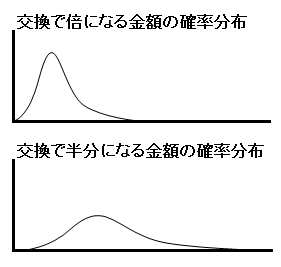
In English
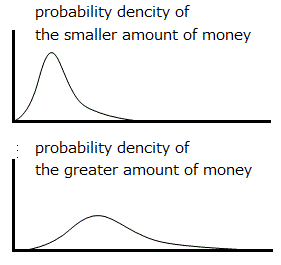
I think that these graphs help us to understand that the probability of switch-then-halved and the probability of switch-then-doubled are usually not same (In other words, the probabilities are usually not 1/2) .
The following articles presented the above density functions in one chart.
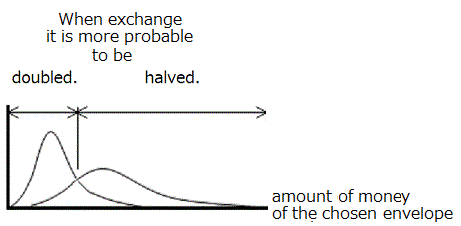
I think that we can easily understand the following knowledge from this chart.
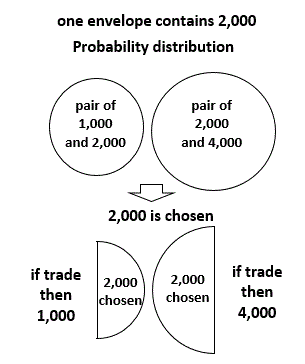
I think that we can easily understand the following knowledge from this drawing.
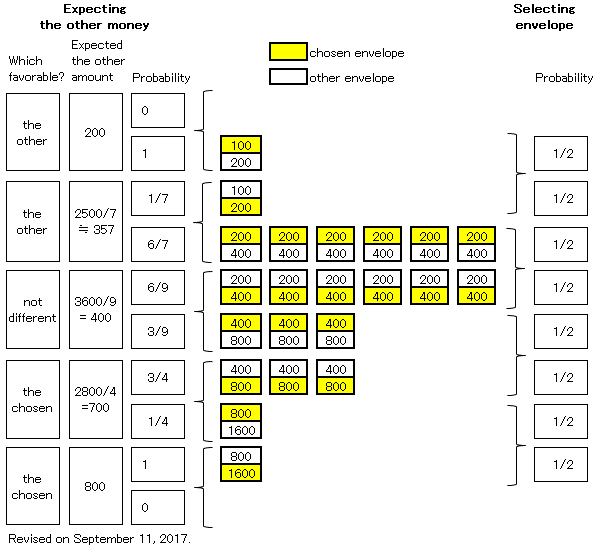
I think that we can easily understand the following knowledge from this diagram.
A game as an explanation of the above knowledge
(Thins paragraph was added on Novenber 5, 2017.)
I made a page "Experiment for experiencing two envelopes problem".
It provides experiment about the probabilities which are concerned on the two envelopes problem and it may help to realize the above knowledge.
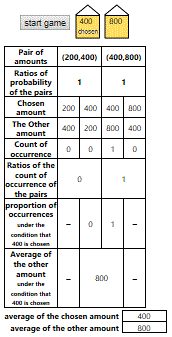
I have drawn two kinds of transition diagram as below to explain the exchange represented by the expectation formula"E=(1/2)(x/2) + (1/2)2x" .
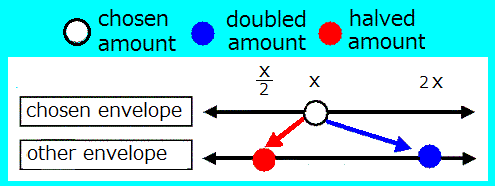
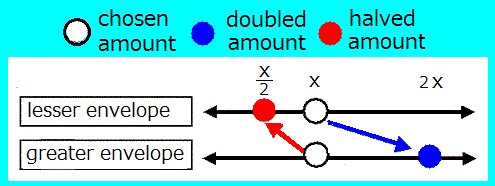
I think that the latter one is better than the former one to explain the followings.
Then you will find explanations easy to understand.
Return to the list of my pages written in English about the two envelopes problem
2020/02/23 2:29:21
First edition 2017/09/15
Two envelopes problem : Which explanation is most easy to understand ?
Caution
I who am a Japanese wrote this page in English, but I am not so good at English.
I who am a Japanese wrote this page in English, but I am not so good at English.
The two envelopes problem and the mathematically standard resolution
The problem
There are two envelopes.
An unexpected amount of money is placed in one envelope, and twice that amount is placed in another envelope.
Because these envelopes are not distinguishable they are equivalent (equally favorable).
You choose one envelope at random.
Let x be the amount of money in your envelope, then the amount of money in the other envelope is equally likely x/2 or 2x.
Therefore the expected amount of money in the other envelope is(1/2)(x/2) + (1/2)(2x) = (5/4)x.
Because (5/4) > x the other envelope is more favorable than the chosen envelope.
<<Various description of the existence of a paradox follows.>>
The mathematically standard paradox (Breaking the law of total expectation)
An unexpected amount of money is placed in one envelope, and twice that amount is placed in another envelope.
Because these envelopes are not distinguishable they are equivalent (equally favorable).
You choose one envelope at random.
Let x be the amount of money in your envelope, then the amount of money in the other envelope is equally likely x/2 or 2x.
Therefore the expected amount of money in the other envelope is
Because (5/4) > x the other envelope is more favorable than the chosen envelope.
<<Various description of the existence of a paradox follows.>>
Because this calculation does not depend on the amount x, so anytime after choice the chosen envelope is less favorable than the opposite envelope.
Before you choose an envelope, two envelopes are equivalent, but after you choose an envelope, the equivalence is broken.
This is a paradox.
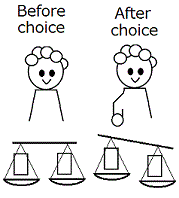
The mathematically standard resolution
Before you choose an envelope, two envelopes are equivalent, but after you choose an envelope, the equivalence is broken.
This is a paradox.
The cause of this paradox is a fallacy of probability.
The probability that the other envelope contains x/2 and the probability that it contains 2x are not necessarily 1/2.
Actual probabilities correspond to the odds of the pair (x/2, x) and the odds of the pair (x, 2x).
Actual probabilities correspond to the odds of the pair (x/2, x) and the odds of the pair (x, 2x).
So there is no wonder even if the opposite envelope is more favorable for a value of the amount of money in the chosen envelope.
And if the opposite envelope is favorable for a value of the amount of money in the chosen envelope, the opposite envelope must be unfavorable for some other value of the amount of money in the chosen envelope. The equivalence of the two envelopes is surely kept.
And if the opposite envelope is favorable for a value of the amount of money in the chosen envelope, the opposite envelope must be unfavorable for some other value of the amount of money in the chosen envelope. The equivalence of the two envelopes is surely kept.
I think that the following explanations are most easy to understand the two envelopes problem.
Which explanation is best?
Which explanation is best?
Explanation using graphs of probability density functions
I have once drawn graphs of probability density functions to understand how to calculate the probabilities p and (1-p) in the expectation formulaOriginal
In English
I think that these graphs help us to understand that the probability of switch-then-halved and the probability of switch-then-doubled are usually not same (In other words, the probabilities are usually not 1/2) .
The following articles presented the above density functions in one chart.
- A web page titled "Dan’s Geometrical Curiosities - Maximizing your earnings with money envelopes: a mathematical riddle"
- A web page titled "NaClhv: The two envelopes problem and its solution"
I think that we can easily understand the following knowledge from this chart.
- The probabilities which are used to calculate expected amount of money of the other envelope are not necessarily 1/2.
- The other envelope is more favorable or equivalent or less favorable depending on the amount of money of the chosen envelope.
Explanation using Venn diagram
I have once drawn Venn diagram to explain the posterior probability is not necessarily 1/2.I think that we can easily understand the following knowledge from this drawing.
- The probabilities which are used to calculate expected amount of money of the other envelope are not necessarily 1/2.
- The other envelope is more favorable or equivalent or less favorable depending on the probability distribution.
Explanation using frequency diagram
I have drawn frequency diagram to explain the posterior probablity is not neccessarily 1/2.I think that we can easily understand the following knowledge from this diagram.
- The probabilities which are used to calculate expected amount of money of the other envelope are not necessarily 1/2.
- The other envelope is more favorable or equivalent or less favorable depending on amount of money of the chosen envelope.
- There is no wonder even if both envelopes are greener than each other.
For example, in the above diagram, if pair of 100 and 200 are arranged , the player who has 100 and the player who has 200 both expect that the opponent envelope is more favorable. (← Added on September 22, 2017.) - If the likelihood of the lesser pair is twice that of the greater pair the two envelopes are equally favorable.
For example, in the above diagram, the event [200 the other, 400 chosen] has twice as many samples as the event [400 chosen, 800 the other] and the chosen envelope and the other envelope (which contains 200 or 800) are equally favorable. (← Revised on December 13-19, 2017, March 3, 2018.) - An event and the corresponding reversal event have same frequency.
For example, in the above diagram, the event [200 chosen, 400 the other] and the event [200 the other, 400 chosen] both have 6 samples.
Therefore it is guaranteed that the two envelopes are equivalent as a whole.
A game as an explanation of the above knowledge
(Thins paragraph was added on Novenber 5, 2017.)
I made a page "Experiment for experiencing two envelopes problem".
It provides experiment about the probabilities which are concerned on the two envelopes problem and it may help to realize the above knowledge.
Explanation using transition diagram
(This paragraph was added on February 23, 2020)I have drawn two kinds of transition diagram as below to explain the exchange represented by the expectation formula
I think that the latter one is better than the former one to explain the followings.
- In the expectation formula
"E=(1/2)(x/2) + (1/2)2x" , the amounts of money denoted by the former symbol x and the latter symbol x are derived from different pairs of amount. - Therefore, both the former probability 1/2 and the latter probability 1/2 are suspicious.
If you have not gotten satisfaction
Please see the page "Interesting web pages about the Two Envelopes Problem".Then you will find explanations easy to understand.
Return to the list of my pages written in English about the two envelopes problem